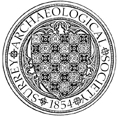The Old Abattoir site, Rose Hill, Dorking
Building recording by Beryl Higgins & Vivienne Ettlinger of one of the former abattoir buildings, to be retained and refurbished, identified it as 17th or 18th century in origin. A watching brief was undertaken by N Shaikhley of SCAU, for Ian Vincent Property, during construction of housing on the remainder of the site. A ceramic vessel, identified as a ‘tyg’ of 17th century date, was found in spoil. No features of archaeological interest were revealed; the site was seen to have been very disturbed. (314, 321)


